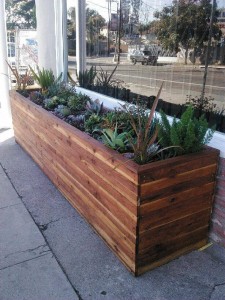Advantages of Raised Beds
So what makes raised beds a better way to grow vegetables?
Just a few advantages to growing in a raised bed;
.
They help to define the edge of your beds and the paths.
Soil works better if it isn’t trodden on and compacted so if the beds are small enough you never have to tread on them to weed or harvest.
Raised beds have clean paths made from grass, woodchip or gravel help to stop you trailing mud into the house.
The soil and plants stay where they are. The soil doesn’t creep out onto the paths like it does in beds that are just mounded up with soil.
With raised beds there is better drainage. This is particularly an advantage in wetter gardens with clay soils, eliminating the chance of root rot. Drier soil can also lengthen the growing season.
The soil in a raised bed warms up more before seed sowing because of the sun shining on the sides. This is better for the germination of the seeds.
With a raised bed you can choose the type of soil that you want in the beds. Sandier soil for carrots, richer soil for pumpkins. Every year you can condition and improve your soil for crop rotation by adding bulking agents like compost and manure.
With deeper raised beds there will be very active root development of the vegetables. This means that you can plant closer together. This helps support taller vegetables and helps to keep the weeds down.
They can fit into any shape of garden. Wood can easily be cut to fit even the oddest of angles.
You can keep your vegetable garden to a manageable size. It is better to start with one or two small beds to build up your confidence and enthusiasm rather than too big and feel overwhelmed.
No heavy digging is necessary after the initial preparations.
With raised beds you can try out square foot gardening. All this means is areas are marked out (usually in one foot squares) on the raised bed and planting different vegetables into each square. One tomato plant could take up one whole square, four strawberry plants in another, and up to sixteen radishes in another. Compact planting in rich soil helps to suppress weeds.
Raised Beds can be built to any height you desire. This is particularly beneficial if there are any mobility issues with the user. Beds can be specifically designed at the correct height for wheelchair users and firm paths in between the beds allow for total access to all parts of the bed and vegetable garden all year round.
It is very easy to grow climbing plants like peas and beans as hazel rods or bamboo poles can be pressed into the sides of the raised beds. This means lots more healthy nutritious vegetables in a smaller surface area. Climbers are Ideal for small gardens.
Raised beds are great for kids to experience the joys of growing their own food. A starter bed just 3’ x 3′ square is enough. All too often children (and adults) can be put off growing vegetables because the plots are too large. A small raised bed gives the child their own personal plot.
In almost all cases we build to order, making exactly the size and quantity you need. Turn around is based on backlog, quantity and difficulty of planter construction. Price is based on design and size. A quantity discount will be applied based on a few factors.
Call, text, or email today and get a quote for your project and let’s start building a garden! Please mention your name and city you want the planters delivered.
Thank you!
Robert Curtis
Quotes on redwood planters, wooden garden boxes, organic vegetables grown at home. Information on gardens, gardening, organic soil, and more. Other wood types, redwood, pine, cedar, fir, oak, teak. Types of organic food you can grow, tomatoes, peas, beets, lettuce, kale, peppers, bell peppers, hot peppers, onions, cucumbers, squash, beans, berries, strawberry, basil, herbs, rosemary, thyme, chives, radishes, potatoes, leeks, greens and anything you can think of!


